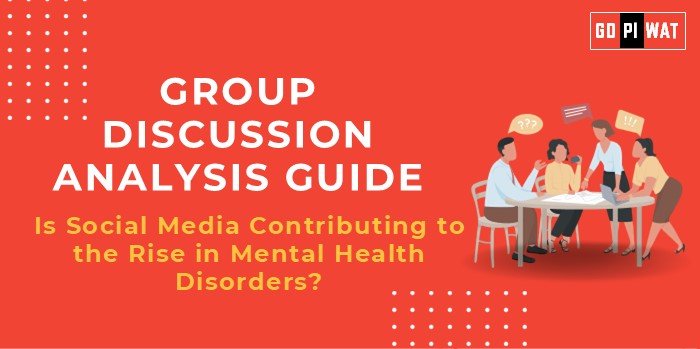📋 Group Discussion Analysis Guide: Is Social Media Contributing to the Rise in Mental Health Disorders?
🌐 Introduction to the Topic
Opening Context: In the digital age, social media platforms have transformed global communication, enabling connections across cultures and geographies. However, this unprecedented connectivity has coincided with a concerning rise in mental health disorders, sparking debates about its role in mental well-being.
Topic Background: The term “social media” encompasses platforms like Facebook, Instagram, Twitter, and TikTok, which collectively engage over 4.9 billion users globally. While these platforms promote expression and community-building, research highlights potential links between excessive use and mental health issues like anxiety, depression, and sleep disturbances. A WHO report estimates a 13% global increase in mental health conditions over the last decade, prompting scrutiny of social media’s influence.
📊 Quick Facts and Key Statistics
- 🌍 Global Social Media Users: 4.9 billion (2024) – Highlighting its ubiquity and influence.
- ⏱️ Screen Time Increase: Average daily usage at 2 hours and 30 minutes per user (2023) – Suggesting potential overexposure.
- 🧠 Mental Health Disorders Prevalence: 1 in 7 adolescents globally suffers from a mental health issue (WHO, 2022).
- ⚠️ Cyberbullying Cases: 37% of teens report being victims – Highlighting social media’s darker implications.
👥 Stakeholders and Their Roles
- 📱 Social Media Platforms: Responsible for algorithm design, content moderation, and promoting well-being initiatives.
- 🏛️ Governments: Enforcing regulations to address misinformation and harmful content.
- 🩺 Healthcare Providers: Raising awareness and providing treatment for social media-induced mental health issues.
- 👥 Users: Cultivating responsible usage habits and recognizing signs of digital addiction.
🏆 Achievements and Challenges
Achievements:
- ✨ Increased Awareness: Campaigns like #MentalHealthAwareness on social platforms.
- 🤝 Community Support: Peer groups and forums providing emotional support.
- 💻 Access to Therapy: Teletherapy sessions facilitated via platforms like Instagram and YouTube.
Challenges:
- ⚠️ Cyberbullying and Harassment: Major contributors to anxiety and depression among users.
- 🪞 Body Image Concerns: Algorithms promoting unattainable beauty standards.
- 📱 Addiction: Dopamine-driven design leading to compulsive use.
🌏 Global Comparisons:
- 🇰🇷 South Korea: High smartphone penetration correlates with one of the world’s highest rates of internet addiction.
- 🇳🇴 Norway: Government-funded programs for responsible social media use among teens.
📖 Case Studies:
India: Cyberbullying-related suicides rose 15% in 2023 among youth (NCRB).
📚 Structured Arguments for Discussion
- ✅ Supporting Stance: “Social media fosters environments where mental health issues like anxiety and body dysmorphia thrive, with cyberbullying and algorithmic content exacerbating the problem.”
- ❌ Opposing Stance: “While social media correlates with mental health concerns, it also serves as a platform for awareness and support, helping users access therapy and community.”
- ⚖️ Balanced Perspective: “Social media’s impact is double-edged, offering both challenges and solutions to mental health issues. Responsible use and regulation can maximize its benefits while mitigating harm.”
🎯 Effective Discussion Approaches
- 💡 Opening Approaches:
- “With nearly 5 billion global users, social media influences mental health on an unprecedented scale…”
- “A 37% cyberbullying rate among teens raises urgent questions about digital well-being.”
- 🛠️ Counter-Argument Handling:
- Acknowledge benefits like teletherapy.
- Highlight gaps, e.g., inadequate safeguards against harmful content.
🔍 Strategic Analysis of Strengths and Weaknesses
Strengths:
- 🩺 Accessibility to mental health resources.
- 🤝 Community building and support.
Weaknesses:
- ⚠️ Algorithms promoting harmful content.
- 📣 Cyberbullying prevalence.
Opportunities:
- 🤖 AI-based moderation to combat harassment.
- 📚 Educational campaigns for digital literacy.
Threats:
- 📉 Rising addiction rates.
- 📰 Misinformation exacerbating mental health issues.
🎓 Connecting with B-School Applications
- 🌟 Real-World Applications: Explore mental health awareness campaigns or digital well-being projects.
- ❓ Sample Interview Questions:
- “How can social media companies balance profit and user well-being?”
- “What role can AI play in addressing cyberbullying?”
- 📘 Insights for B-School Students:
- Understand ethical tech, user behavior analysis, and policy-making related to digital platforms.


